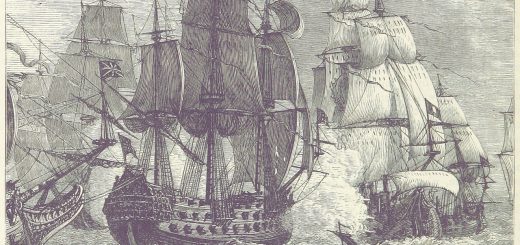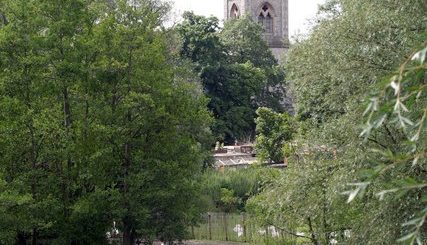Major Peter Labilliere, Box Hill
‘According to local folklore, an eccentric sword-wielding officer, Major Peter Labelliere, roams the summit by his grave, where he was buried upside down, as instructed in his will, in 1800.’ [Surrey Life, ‘Surrey’s most haunted sites – spooky Halloween stories’ – 19 October 2015].
 In his ‘English Eccentrics and Eccentricities (1898), John Timbs gives the following description of Major Labelliere. ‘On the north-western brow of Box Hill, and nearly in a line with the stream of the Mole, as it flows towards Burford Bridge, was interred, some sixty-five years since, Major Peter Labelliere, an officer of marines. During the latter years of his life he had resided at Dorking, and, in accordance with his own desire, he was interred on this spot, long denoted by a wooden stake or stump. This gentleman in early life fell in love with a lady, who, although he was remarkably handsome in person, rejected his addresses. This circumstance inflicted a deep wound on his mind, which, at a later period, religion and politics entirely unsettled. Yet his eccentricities were harmless, and himself the only sufferer. At this time the Duke of Devonshire, who had been formerly fond of the major’s society, settled on him a pension of 100l. a year. Labelliere then lived at Chiswick, and there wrote several tracts, both polemical and political, but the incoherency of his arguments was demonstrative of mental incapacity. From Chiswick he frequently walked to London, his pockets filled to overflowing with newspapers and pamphlets, and on the road he delighted to harangue the ragged boys who followed him. He next removed to Dorking, and there resided in a mean cottage, called “The Hole in the Wall,” on Butter Hill. Among the anecdotes of his eccentricity it is related that, to a gentleman with whom he was intimate he presented a packet, carefully folded and sealed, with a particular injunction not to open it till after his death. This request was strictly complied with, when it was found to contain merely a blank memorandum-book.
In his ‘English Eccentrics and Eccentricities (1898), John Timbs gives the following description of Major Labelliere. ‘On the north-western brow of Box Hill, and nearly in a line with the stream of the Mole, as it flows towards Burford Bridge, was interred, some sixty-five years since, Major Peter Labelliere, an officer of marines. During the latter years of his life he had resided at Dorking, and, in accordance with his own desire, he was interred on this spot, long denoted by a wooden stake or stump. This gentleman in early life fell in love with a lady, who, although he was remarkably handsome in person, rejected his addresses. This circumstance inflicted a deep wound on his mind, which, at a later period, religion and politics entirely unsettled. Yet his eccentricities were harmless, and himself the only sufferer. At this time the Duke of Devonshire, who had been formerly fond of the major’s society, settled on him a pension of 100l. a year. Labelliere then lived at Chiswick, and there wrote several tracts, both polemical and political, but the incoherency of his arguments was demonstrative of mental incapacity. From Chiswick he frequently walked to London, his pockets filled to overflowing with newspapers and pamphlets, and on the road he delighted to harangue the ragged boys who followed him. He next removed to Dorking, and there resided in a mean cottage, called “The Hole in the Wall,” on Butter Hill. Among the anecdotes of his eccentricity it is related that, to a gentleman with whom he was intimate he presented a packet, carefully folded and sealed, with a particular injunction not to open it till after his death. This request was strictly complied with, when it was found to contain merely a blank memorandum-book.
Long prior to his decease he selected the point of Box-Hill we have named, where, in compliance with his oft-expressed wish, he was buried, without church rites, with his head downwards; in order, he said, that as “the world was turned topsy-turvy, it was fit that he should be so buried that he might be right at last.” He died June 6th, 1800, and was interred on the 10th of the same month, when great numbers of persons witnessed his funeral; and the slight wooden bridge which then crossed the Mole having been removed by some mischievous persons during the interment many had to wade through the river on returning homewards.’
It is also said that Major Peter Labilliere (Born Dublin 30 May 1725 – Died 1800) accurately predicted his own death. The following extract is from an article by W. H. Chouler which was published in the Surrey Mirror in July 1963. ‘When over 70 years of age, the Major made a stay of three months with the Duke of Devonshire. On his return to a very worried landlady, he forecast his own death: “Now I have come back to live and die with you, for this day nine months hence I shall depart out of this world”. His landlady made a note of the day and it came to pass that on the very day mentioned, Major Peter Labelliere “stretched out his arms, then gently folded them, and died like a lamb”.
The Major made two strange requests. One was, as we have seen, to be buried upside down on Box Hill, and the other was that the youngest son and daughter of his landlady should dance upon his coffin. The little girl, however, could not be persuaded to carry out this strange wish, but the little boy did as he was asked, and remembered the incident vividly for the rest of a very long life.’
Major Peter Labilliere’s gravestone can be found on Box Hill




Recent Comments